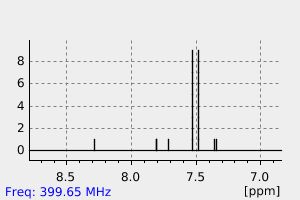3-(2-nitrovinyl)-1-phenylindole | 70837-57-9
中文名称
——
中文别名
——
英文名称
3-(2-nitrovinyl)-1-phenylindole
英文别名
3-[(E)-2-nitroethenyl]-1-phenylindole
CAS
70837-57-9
化学式
C16H12N2O2
mdl
——
分子量
264.283
InChiKey
JHTQRJSIADSEBT-ZHACJKMWSA-N
BEILSTEIN
——
EINECS
——
-
物化性质
-
计算性质
-
ADMET
-
安全信息
-
SDS
-
制备方法与用途
-
上下游信息
-
文献信息
-
表征谱图
-
同类化合物
-
相关功能分类
-
相关结构分类
计算性质
-
辛醇/水分配系数(LogP):3.9
-
重原子数:20
-
可旋转键数:2
-
环数:3.0
-
sp3杂化的碳原子比例:0.0
-
拓扑面积:50.8
-
氢给体数:0
-
氢受体数:2
上下游信息
-
上游原料
中文名称 英文名称 CAS号 化学式 分子量 1-苯基吲哚-3-甲醛 1-phenyl-1H-indole-3-carbaldehyde 32542-59-9 C15H11NO 221.258 -
下游产品
中文名称 英文名称 CAS号 化学式 分子量 —— (E)-1-(N-phenyl-3-indolyl)-1-butene —— C18H17N 247.34 —— (E)-3,3-dimethyl-1-(N-phenyl-3-indolyl)-1-butene —— C20H21N 275.393 —— (E)-1-cyclohexyl-2-(N-phenyl-3-indolyl)ethene —— C22H23N 301.431
反应信息
-
作为反应物:描述:3-(2-nitrovinyl)-1-phenylindole 以0%的产率得到参考文献:名称:Takeshita Mitsuhiro, Yoshida Sachiko, Kohno Yoichiro, Heterocycles, 37 (1994) N 1, S 553-562摘要:DOI:
-
作为产物:描述:参考文献:名称:1-Phenyl-azepinoindoles摘要:一种1,2,3,4,5,6-六氢-6-苯基-氮杂七环[4,5-b]吲哚,或其药用可接受的酸盐是一种有用的神经阻滞剂、抗抑郁剂和抗过敏剂。公开号:US04478750A1
文献信息
-
Generation of nitroalkanes, hydroximoyl halides and nitrile oxides from the reactions of β-nitrostyrenes with Grignard or organolithium reagents作者:Ching-Fa Yao、Kuo-Hsi Kao、Ju-Tsung Liu、Cheng-Ming Chu、Yeh Wang、Wen-Chang Chen、Yu-Mei Lin、Wen-Wei Lin、Ming-Chung Yan、Jing-Yuan Liu、Ming-Ching Chuang、Jin-Lien ShiueDOI:10.1016/s0040-4020(97)10356-8日期:1998.1products 6 and/or 7 are observed if the nitronates, generated from the substrate 1a, are added to 85% aqueous H2SO4 but only the hydrolyzed carboxylic acids 9 are generated when the β-nitrostyrenes 2 are reacted with Grignard reagents and worked up under the same condition. The nitrile oxides 7 can undergo 1,3-dipolar cycloaddition with alkenes or alkynes to generate 2-isoxazolines or isoxazoles. A one-potβ型硝基苯乙烯1或2与格氏或有机锂试剂反应在乙醚或THF溶液由1,4-加成中间nitronates以产生甲。当用稀盐酸处理A时,获得高产率的硝基烷3(和肟4)或5。当将中间体A缓慢加入到冰冷的浓氢卤酸中时,可以分离出羟甲酰卤6、8或一氧化氮7。如果从基材1a产生的硝酸盐观察到相同的产物6和/或7。将β-硝基苯乙烯2加入到85%的H 2 SO 4水溶液中,但是当β-硝基苯乙烯2与格氏试剂反应并在相同条件下进行后处理时,仅产生水解的羧酸9。腈氧化物7可与烯烃或炔烃进行1,3-偶极环加成反应以生成2-异恶唑啉或异恶唑。据报道,通过分子内一氧化氮-烯烃环加成反应可以一锅合成[n,3,0]双环(n = 3或4)化合物23-27。
-
Novel Synthesis of Alkenes via Triethylborane-Induced Free-Radical Reactions of Alkyl Iodides and <i>β</i>-Nitrostyrenes作者:Ju-Tsung Liu、Yeong-Jiunn Jang、Yuh-Kuo Shih、Shin-Ru Hu、Cheng-Ming Chu、Ching-Fa YaoDOI:10.1021/jo010213m日期:2001.9.1iodides 6 and 8 or tertiary alkyl iodides 9, 11, and 13, in the presence of 2 and air as radical initiator. The generation of the only product (E)-alkenes can be explained by the generation of the benzylic radical A and/or B as the intermediate only and the mechanism is similar to Scheme 1. Both (E)- and (Z)-16a-c are generated when (E)- and (Z)-15a-c are used to react with adamantyl radical under similar(E)-β-硝基苯乙烯1和三乙基硼烷2或三环己基硼烷4在室温下在空气中存在氧气作为自由基引发剂的条件下的反应产生高产率的反式烯烃(E)-3或(E)- 5,当1与由仲烷基碘化物6和8或叔烷基碘化物9制备的不同基团反应时,也可以制备中等至高产率的不同的(E)-烯烃(E)-5、7、10、12和14。参照图11和13,在2和空气的存在下作为自由基引发剂。唯一产物(E)-烯烃的产生可以通过仅作为中间体的苄基基团A和/或B的产生来解释,其机理与方案1相似。(E)-和(Z)-16a当(E)-和(Z)-15a-c与金刚烷基在相似条件下反应时,生成-c。当使用(E)-或(Z)-15d与金刚烷基自由基反应时,仅观察到(Z)-16d。(E)-和/或(Z)-烯烃的生成可以通过A和/或B自由旋转以生成A'和/或B'来解释,反之亦然,并且该机理被认为是通过NO 2 /烷基取代的自由基反应,如方案2所示。
-
One-pot synthesis of five- or six-membered carbocycles through intramolecular cycloadditions by the use of ethyl chloroformate作者:Ju-Tsung Liu、Wen-Wei Lin、Jeong-Jiunn Jang、Jing-Yuan Liu、Ming-Chung Yan、Chihua Hung、Kuo-Hsi Kao、Yeh Wang、Ching-Fa YaoDOI:10.1016/s0040-4020(99)00351-8日期:1999.6compounds 9 is proposed to proceed through intramolecular nitrile oxide-olefin cycloadditions (INOC) because compounds 14a-d, obtained from the trapping of the nitrile oxides by ethyl chloroformate, could be isolated. The mechanism of the generation of compounds 10 is proposed to proceed through intramolecular alkoxycarbonyl nitronate-olefin cycloadditions (IAOC) to form intermediates N-(ethoxycarbonyl)isoxazolidinesβ-硝基苯乙烯1与4-戊烯-1-溴化镁2a或3-丁烯-1-溴化镁2b的迈克尔加成反应生成了硝酸盐3或4。中等至异恶唑烷衍生物的高的产率9和10时nitronates获得3或4用氯甲酸乙酯和在一釜在室温下4-二甲基氨基吡啶(DMAP)催化量和比率处理反式- 9:顺式- 9来自1:3.00至1:4.06和的比率反式- 10:顺式- 10分别为> 99:1。提议化合物9的形成通过分子内腈氧化物-烯烃环加成(INOC)进行,因为可以分离出由氯甲酸乙酯捕获腈氧化物而获得的化合物14a-d。提出化合物10的生成机理是通过分子内烷氧基羰基亚硝酸盐-烯烃环加成反应(IAOC)形成中间体N-(乙氧基羰基)异恶唑烷13,然后消除EtOH和CO 2(或EtOCO 2 H),得到最终产物。
-
Synthesis of Pyrazolo[3,4-b]pyridines by Cycloaddition Reactions under Microwave Irradiation作者:Angel Dı́az-Ortiz、José Ramón Carrillo、Fernando P Cossı́o、Marı́a J Gómez-Escalonilla、Antonio de la Hoz、Andrés Moreno、Pilar PrietoDOI:10.1016/s0040-4020(00)00059-4日期:2000.3Microwave irradiation induces the cycloaddition of pyrazolylimines with aromatic and aliphatic nitroalkenes to afford pyrazolo[3,4-b]pyridines in 5–20 min. Some of these reactions do not occur under classical heating. Tricyclic heterocycles can be synthesized from cycloalkenes. The reactivity and regiochemistry can be understood in terms of the energy and atomic coefficients of the frontier orbital
-
First Diels-Alder Reaction of Pyrazolyl Imines under Microwave Irradiation作者:Angel Díaz-Ortiz、José R. Carrillo、María J. Gómez-Escalonilla、Antonio de la Hoz、Andrés Moreno、Pilar PrietoDOI:10.1055/s-1998-1881日期:1998.10Microwave irradiation in solvent-free conditions induces pyrazolyl 2-azadienes to undergo Diels-Alder cycloadditions with nitroalkenes within 5-10 min to give good yields of pyrazolo[3,4-b]pyridines. This is the first example of a [4 + 2] cycloaddition of a 2-azadiene involving a pryazole ring. By classical heating, these reactions do not occur or afford only traces of the products.
表征谱图
-
氢谱1HNMR
-
质谱MS
-
碳谱13CNMR
-
红外IR
-
拉曼Raman
-
峰位数据
-
峰位匹配
-
表征信息
同类化合物
黄胆红酸
高树蛙毒素
颜料红2254
阿根诺卡菌素
阿托伐他汀镁
阿托伐他汀钙阿托伐他汀钙中间体1甲酯
阿托伐他汀钙杂质59
阿托伐他汀钙杂质52
阿托伐他汀钙杂质43
阿托伐他汀钙杂质
阿托伐他汀钙杂质
阿托伐他汀钙三水合物
阿托伐他汀钙L-8
阿托伐他汀钙
阿托伐他汀酸异丙酯
阿托伐他汀酰基-Β-D-葡糖苷酸
阿托伐他汀缩丙酮
阿托伐他汀相关化合物E
阿托伐他汀甲酯
阿托伐他汀甲胺盐
阿托伐他汀烯丙基酯
阿托伐他汀杂质F
阿托伐他汀杂质95
阿托伐他汀杂质5
阿托伐他汀杂质31
阿托伐他汀杂质1
阿托伐他汀叔丁酯
阿托伐他汀双氟杂质中间体
阿托伐他汀内酯-[D5]
阿托伐他汀内酯
阿托伐他汀乙酯
阿托伐他汀USP相关物质E
阿托伐他汀L1二胺物杂质
阿托伐他汀3-羟基消除杂质
阿托伐他汀3-氧杂质
阿托伐他汀
阿利考昔
阿伐他汀钠
镍(II)(吡唑二氰胺)2
镉原卟啉IX二甲酯
铬,二溴二(吡啶)-
达考帕泛
费耐力
角质形成细胞分化诱导剂
西拉美新盐酸盐
西拉美新
虫螨腈
萨格列扎
苏尼替尼N-1
芬度柳







